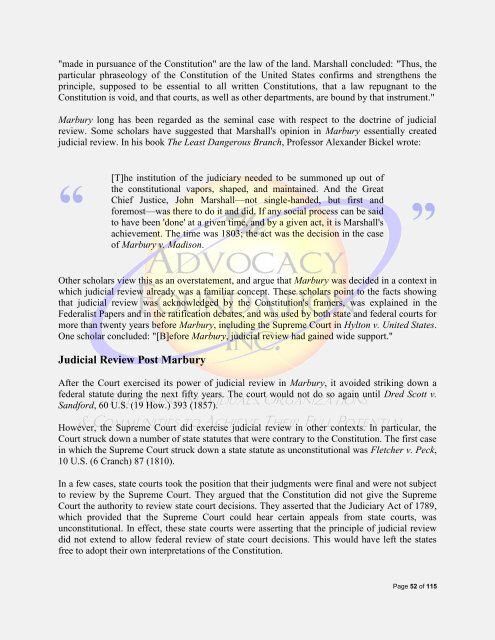Judicial ReEngineering
Judicial ReEngineering
Judicial ReEngineering
You also want an ePaper? Increase the reach of your titles
YUMPU automatically turns print PDFs into web optimized ePapers that Google loves.
"made in pursuance of the Constitution" are the law of the land. Marshall concluded: "Thus, the<br />
particular phraseology of the Constitution of the United States confirms and strengthens the<br />
principle, supposed to be essential to all written Constitutions, that a law repugnant to the<br />
Constitution is void, and that courts, as well as other departments, are bound by that instrument."<br />
Marbury long has been regarded as the seminal case with respect to the doctrine of judicial<br />
review. Some scholars have suggested that Marshall's opinion in Marbury essentially created<br />
judicial review. In his book The Least Dangerous Branch, Professor Alexander Bickel wrote:<br />
“<br />
[T]he<br />
institution of the judiciary needed to be summoned up out of<br />
the constitutional vapors, shaped, and maintained. And the Great<br />
Chief Justice, John Marshall—not single-handed, but first and<br />
foremost—was there to do it and did. If any social process can be said<br />
to have been 'done' at a given time, and by a given act, it is Marshall's<br />
achievement. The time was 1803; the act was the decision in the case<br />
of Marbury v. Madison.<br />
”<br />
Other scholars view this as an overstatement, and argue that Marbury was decided in a context in<br />
which judicial review already was a familiar concept. These scholars point to the facts showing<br />
that judicial review was acknowledged by the Constitution's framers, was explained in the<br />
Federalist Papers and in the ratification debates, and was used by both state and federal courts for<br />
more than twenty years before Marbury, including the Supreme Court in Hylton v. United States.<br />
One scholar concluded: "[B]efore Marbury, judicial review had gained wide support."<br />
<strong>Judicial</strong> Review Post Marbury<br />
After the Court exercised its power of judicial review in Marbury, it avoided striking down a<br />
federal statute during the next fifty years. The court would not do so again until Dred Scott v.<br />
Sandford, 60 U.S. (19 How.) 393 (1857).<br />
However, the Supreme Court did exercise judicial review in other contexts. In particular, the<br />
Court struck down a number of state statutes that were contrary to the Constitution. The first case<br />
in which the Supreme Court struck down a state statute as unconstitutional was Fletcher v. Peck,<br />
10 U.S. (6 Cranch) 87 (1810).<br />
In a few cases, state courts took the position that their judgments were final and were not subject<br />
to review by the Supreme Court. They argued that the Constitution did not give the Supreme<br />
Court the authority to review state court decisions. They asserted that the Judiciary Act of 1789,<br />
which provided that the Supreme Court could hear certain appeals from state courts, was<br />
unconstitutional. In effect, these state courts were asserting that the principle of judicial review<br />
did not extend to allow federal review of state court decisions. This would have left the states<br />
free to adopt their own interpretations of the Constitution.<br />
Page 52 of 115

















